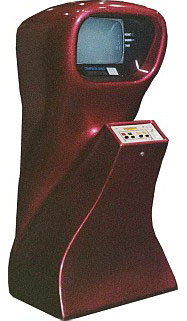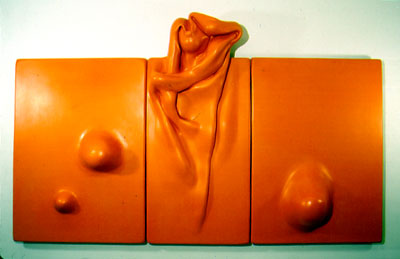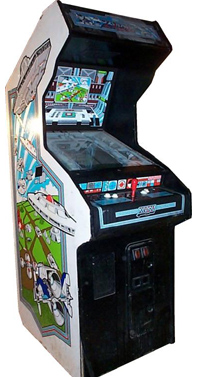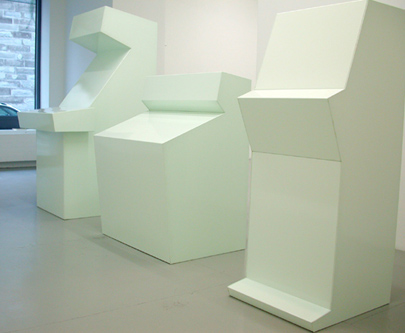I was recently interviewed by Bia Santarosa, Victor Musso and Leo Zenun, students at ESPM São Paulo, for their final paper on the topic of animated GIFs and "minimal communication." This Q&A gave me an opportunity to update some of my thinking about GIFs in my own work, so with their permission I'm reproducing it here.
When did you become interested in art? What's your trajectory been like?
I’ve made art since childhood and published cartoons in my high school newspaper. In college I double-majored in art and English literature and after graduating I continued my studies at the Corcoran School of Art in Washington DC and School of Visual Arts in NY. I opted not to pursue an MFA since I had little interest in teaching. I began showing my paintings at a cooperative gallery in Dallas, Texas and eventually moved to commercial galleries in NY and elsewhere. Mine has always been a “fine art” practice, as opposed to illustration or graphic design.
When did you start making gifs?
I started making animated .gifs in 2003. At that point they were already considered “retro” (an art form associated with the ‘90s and the dot com era). I was interested in their potential as an art form combining painting and film.
Also, do you have an opinion about net art and its history? How did image archives begin being spread, for instance, and what’s the interest around it?
The history of net art is very tied to tech developments and changes. Thus you had solo, self-hosted sites in the ‘90s, blog-based sites in the ‘00s (still mostly self-hosted), then beginning in the mid-2000s, the rise of aggregators (Flickr, delic.io.us, tumblr) and eventually the full-blown, monopoly-owned social media we have now. Each change required an adjustment in people’s ideas of art, or what was the “right” kind of art for the respective platform. For example, .gifs went from simple graphic elements in the ‘90s to stand-alone art in the ‘00s (which could be passed from site to site) to a meme craze in the late ‘00s/early ‘10s where “gif” became synonymous with “short repeating popular movie clip.” What started (certainly in my case) as a renegade art practice became tamed and appropriated by corporate social media, so that now many “gifs” aren’t actually .gif files, but are looping .mp4 videos (Twitter even pastes the word “GIF” on these non-.gif files).
What relationship do you see between gif and art, and art and minimalism?
Aesthetically I was certainly interested in the simplicity and low frame rate of animated .gifs. These were succinct “art statements” that any browser could read and didn’t require proprietary players to activate. In the early ‘00s the main way of presenting video was clumsy “Flash” players that had to be embedded in the page, unlike .gifs, which began playing immediately in the browser when loaded. With the complete dominance of “social” the context has changed and the “gif style” has been reincorporated as another form of video. Video players have gotten more universal and less cumbersome as bandwidth has increased. Many of my peers from the renegade .gif days are quite comfortable having Twitter convert their efforts into .mp4 videos now – something I’m not particularly interested in.
Do you have a target audience?
My target audience is the art world and it was interesting how animated .gifs leapt outside that frame because they were so easily transmissible. By the mid-’00s I was accustomed to seeing my minimal, abstract artworks being used as eye candy on people’s Livejournal and YouTube pages (early YouTube pages were more customizable and allowed tiled animation backgrounds).
Have you done any jobs for a label?
No, my work has stayed in the fine art context. Sold in galleries as prints or editioned DVDs.
Considering that nowadays people have been paying less and less attention to everything (Economy of Attention), what do you think is the role of gifs in Art?
As stated above, .gifs have been largely subsumed into corporate culture and no longer function as a rogue element being passed from person to person outside these networks, or sold in galleries as fine art. There was a brief flurry of interest in “animated GIFs as art” but I think that’s died down. I am not conversant enough with the recent “NFT art” craze to know whether “gifs” are being offered for sale as .gif files, or whether they are just a style or flavor of video art moving in the blockchain context. My guess is the tech buyers don’t care much about these distinctions, or other art historical considerations – they are more interested in how technology confers ownership.
Is there any social media that enhances your work? (Whether by the public present on it or by its format)
I was an early adopter of the blog format, beginning in 2001. I participated in several group blogs run by like-minded artists throughout the 2000s. These predated Tumblr, a corporate-run social media site that incorporated ideas of blogging and reblogging and attracted many artists. I never joined Tumblr, preferring my “old school blogging” approach.
In 2010 the artist Ryder Ripps and others created dump.fm, which was a meme-type site built around IRC (Internet Relay Chat). Dump was basically a ‘90s, AOL-style chat room but with the ability to post images or groups of images. I was very active there until it shut down in 2016 and I have continued to be involved with IRC communities.
I was active on Twitter from 2008 to 2018, but only for text and writing – once the site added images and video (and advertisements) I lost interest.
The mid-2010s saw a mass migration of the art world to Instagram. Again, something I avoided, not wanting to have involvement with any Mark Zuckerberg project.
What's your creative process? Do you follow specific formulas or are you usually taken by sensibility? What are your inspirations?
I’m working on several fronts: digital painting (in the form of image files and ink jet prints), animation and video, and music. There is some crossover of these interests but mostly I keep them separate. I am inspired by the whole range of cultural production, from fine art to commercial to outsider.




